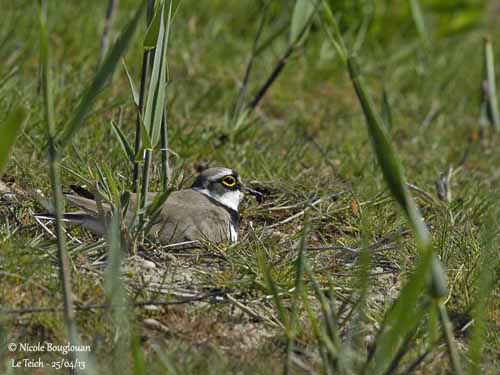
TO BE CONTINUED... Page 10
Text by Nicole Bouglouan
Photographers:
Roger Ahlman
Pbase Galleries Peru and Ecuador
John Anderson
John Anderson Photo Galleries
Jean-Claude Billonneau
Photographe-témoin de la Beauté du Monde
Steve Garvie
RAINBIRDER Photo galleries & Flickr Rainbirder
Eduardo Andrés Jordan
MIS AVES – AVES DE ARGENTINA
René Lortie
http://rlortie.ca
Tom Merigan
Tom Merigan’s Photo Galleries
Bob Moul
Nature Photography
Otto Plantema
Trips around the world
Philippe and Aline Wolfer
OISEAUX D'ARGENTINE
Nicole Bouglouan
Photographic ramble
These images and the text are subject to copyright and cannot be used without express authorization from the owners. Legal issues
Sources :
HANDBOOK OF THE BIRDS OF THE WORLD Vol 3 by Josep del Hoyo-Andrew Elliott-Jordi Sargatal - Lynx Edicions - ISBN : 8487334202
L’ENCYCLOPEDIE MONDIALE DES OISEAUX - Dr Christopher M. Perrins - BORDAS - ISBN: 2040185607
Wikipedia, the free encyclopaedia
Bird nests: Variety is Key for the world’s avian Architects
Be on the lookout for bird nests
The design and function of birds' nests
The bird and its nest, where everything starts…
Page 9 : Charadriidae, Scolopacidae, Pedionomidae, Thinocoridae, Chionidae, Stercorariidae, Laridae, Sternidae, Rynchopidae and Alcidae
Second part
At the beginning of the breeding season and following several courtship displays, the nest-site is selected by the pair, or one of the members of the pair, and the nest is built within this area. For numerous species, the nest is the place where displays and copulation occur. It plays a very important role during the nesting period. It is the cradle of the chicks, the place where the adults feed them prior to their first flight towards independence.
The birds of the family Charadriidae are small to medium-sized shorebirds. They can be found in all regions except Antarctic. They frequent wet and/or dry open habitats such as large variety of wetlands, coastal shoreline, but also grassland, tundra, steppe and even semi-desert. They feed on small invertebrates including arthropods and worms living close to the ground.
The shorebirds living in terrestrial habitats feed primarily on various insects and their larvae, sometimes supplemented by berries and seeds. On the other hand, for the birds living in wet and aquatic habitats, aquatic insects and small crustaceans are the main part of the diet, whereas in mostly marine habitats, they feed on small molluscs and crustaceans.

On the nest
They breed when the food resources, and mainly arthropods, are abundant. They are generally monogamous with some exceptions. The territory is defended mainly by the male, but in some species, both mates share this task.
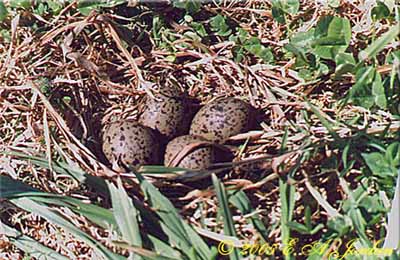
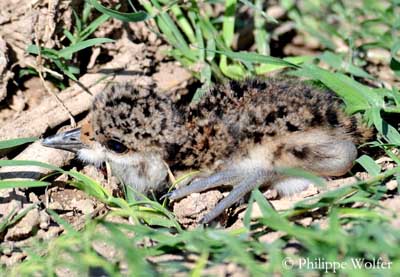
Chick
They usually nest on the ground, in a shallow scrape which is sometimes lined with pebbles or pieces of shells when placed on the shore. The lining is made with grass leaves when the nest is made in meadows, and with pieces of lichen or moss on moorland and tundra. Several shorebirds that breed on beaches lay directly the eggs in a depression in the sand. The eggs have cryptic colour making them difficult to find on the ground.
The chicks are precocial and able to feed themselves, but both parents remain with them for long time.
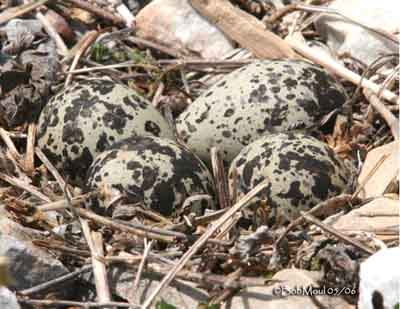
The family Scolopacidae differs from the Charadriidae by some morphological features, and especially the hind toe displayed by most of its members. This peculiar feature allows these waders to perch in trees, and some of them will even nest in trees, often using abandoned nests.
Waders have adapted bills and legs, according to their feeding behaviour, but we can find four feeding styles in this family. Outside the breeding season, they tend to forage in compact groups. These flocks provide defence against potential predators.
The breeding behaviour of waders includes monogamy and polyandry, according to the species. Most of species are monogamous, but there is great flexibility and sometimes, the females may mate with different males.
In phalaropes, the roles are reversed with female having brighter plumage than male, defending the territory and displaying. They are polyandrous.
Shorebirds usually nest on the ground, in shallow depression or scrape, lined or not with soft vegetation. A few species may build a nest in thick plants or in tree.
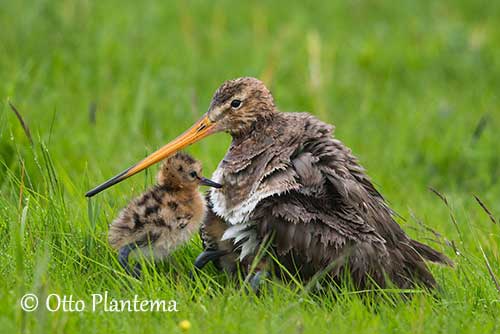
The nest-site is variable according to the species. They breed in wet marshy grounds, dry uplands and bare stony tundra, rock slides, gravel bars in mountain river bed above the tree-line, among vegetation near fresh water, in forest on soft ground at base of tree or shrub, and some sandpipers may use old thrush nest in tree.
The pear-shaped eggs are cryptic in colour, and are well camouflaged on the ground. The chicks are highly precocial and can walk and pick up food items within a few hours of hatching.
Several species remain on the nest even if intruders approach, waiting for the final second to “explode” in the face of the intruder.
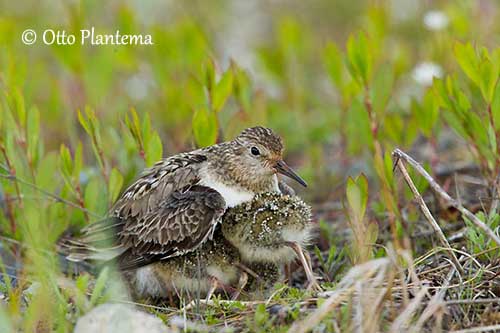
The Plains-wanderer is the sole member of the family Pedionomidae. It is found only in eastern Australia.
In this species, the female is larger and brighter coloured than the male, involving reversed sexual roles during the breeding season. The male incubates the eggs and rears the chicks while the polyandrous female pairs with other males.
They nest on the ground, in a shallow scrape lined with grass. The nest-site is usually in grassland, and the scrape is often protected by some plant alongside or above the nest. The birds may pull grasses together in order to form a concealing roof above the depression. The nests are placed 250-400 metres apart.
The pyriform eggs are cryptically coloured and the chicks are precocial. They are accompanied by the male when they are foraging. It protects them strongly against predators and intruders.
The seedsnipes of the family Thinocoridae are endemic to Patagonia and the Andean zone. There are two genera and four species, fairly similar to quails or partridges except for the long, pointed wings. They have cryptic plumage with mottled and scalloped upperparts, and black, brown or rufous colours.
They frequent grassland, semi-desert and alpine habitats, and occur in the most inhospitable parts of the South American continent. They feed on leaves, buds and seeds from several plant species while walking slowly and biting off tiny bits of plants.
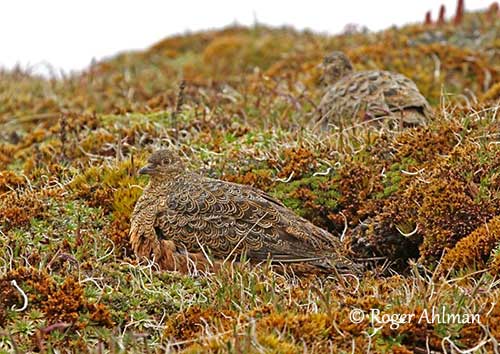
The seedsnipes seems to be monogamous and territorial. They are usually seen in pairs and in small groups, probably family parties. The nest is on the ground, a scrape lined with mosses and plant debris, often placed close to a stone, a grass tussock or a small shrub. Numerous nests can be placed in dry horse dung too.
The eggs are cryptically coloured and incubated mainly by the females, while the male remains perched close to the nest. When she leaves the nest, she covers the eggs with plant debris. The chicks are highly precocial and are able to feed themselves.
The sheathbills of the family Chionidae are the only birds breeding entirely within Antarctic and sub Antarctic regions. This family includes two species of the same genus “Chionis”. They have slightly different appearance and non-overlapping ranges. However, they have very similar behaviour.
These sturdy birds have strong legs and feet, well adapted to their ground habits. As they do not have webbed feet, they are not adapted for aquatic behaviour. On the ground, they have chicken-like gait but they can run rapidly and fly very well.
They forage along the shoreline on rocky and sandy beaches where they can find invertebrates among the rotting piles of algae. They may wander about one kilometre inland in meadows, bogs and tussock grass to find terrestrial insects and earthworms. They are very opportunistic feeders, and take advantage of any food item found on the ground or stolen from other seabird.
Resting on the ground
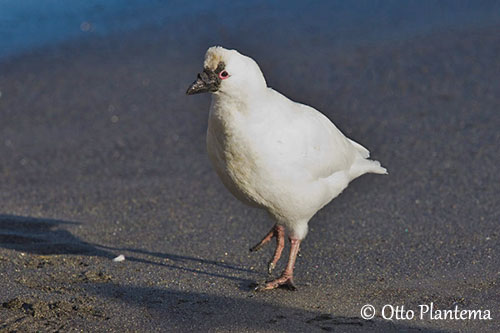
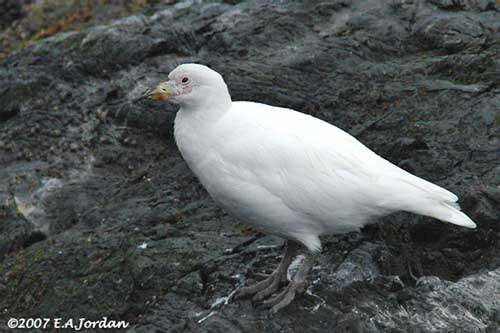
Their breeding territories are often close to penguin colonies and even include part of it. Their breeding cycle is closely related to that of penguins which provide them food during the nesting period, and protection against predators.
During the breeding season, the sheathbills call to establish the territory and they strongly defend it.
The nest is usually hidden in crevices or small caves, or even abandoned petrel’s burrows, usually within the feeding territory. This is a cup placed at top of piles of smelling, untidy algae, tussock grass, feathers and debris.
The brown downy chicks are reared by both parents and fledge 50-60 days after hatching.
The family Stercorariidae includes seven species of genus Stercorarius divided into two groups. The first group includes the skuas of former genus Catharacta, today genus Stercorarius, which are the largest species, and the second group includes three smaller species.
Skuas and jaegers regularly perform kleptoparasitism, stealing food from other seabirds. They are called “the raptors of the seas”. They harass their victims in aerial pursuit, and make them regurgitate or drop their food. However, piracy may sometimes lead to genuine attack. Piracy and kleptoparasitism are the main ways to feed during winter, when skuas and jaegers are in their wintering areas and often at sea. But during the breeding season, when the birds are on land, they depend more on terrestrial animals and berries than fish.
Most species use the same territory and have strong, long-term pair-bonds for many years. They are monogamous, although some males may mate with several females and form trios, often two males and one female.
Many territories are on rocky areas at the edge of the sea, and these limited available habitats often involve group formation. These groups are very stable with long-term bonds, and may remain intact for several consecutive years.
They often breed in colonies but also as isolated pairs. Colonial-breeding is often the consequence of restricted nesting habitats and local abundant food sources.
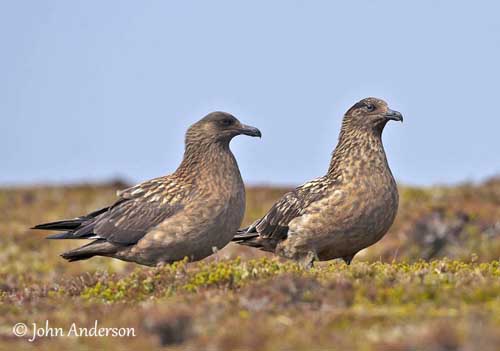
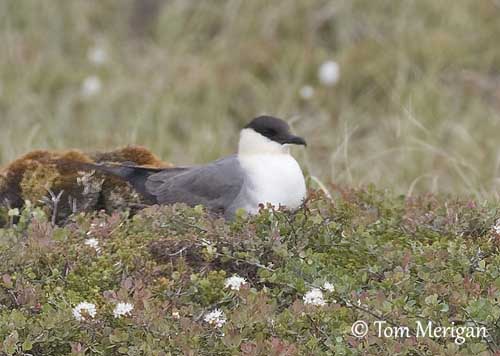
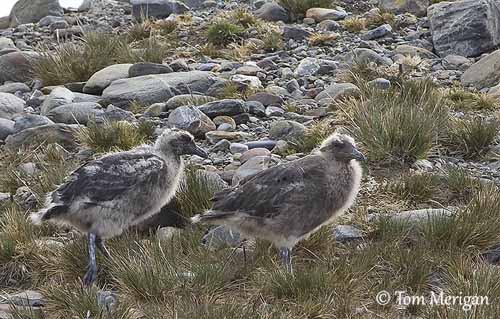
Chicks
The family Laridae includes gulls, terns, noddies and skimmers. All are closely related to oceans and seas throughout the world.
Gulls may have slim body, but some of them are bulkier. The long, narrow wings are often pointed. The tail is usually broad and mostly rounded. They use several methods for feeding. They catch insects in the air, flying in circles over water or wet areas. They also pluck items from the surface of water or land, or perform plunge-diving. They swim and dip into the water to snare the preys.
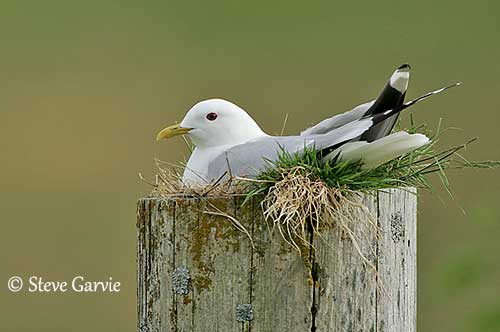
Terns are usually slimmer than gulls. The main criterion is the deeply forked tail with often elongated outer rectrices. They are more specialized foragers than gulls. They use their agility in flight for feeding, and most of them are able to perform several methods such as contact-dipping, aerial-dipping, hover-dipping, surface-dipping, but also aerial hawking for flying insects and piracy.
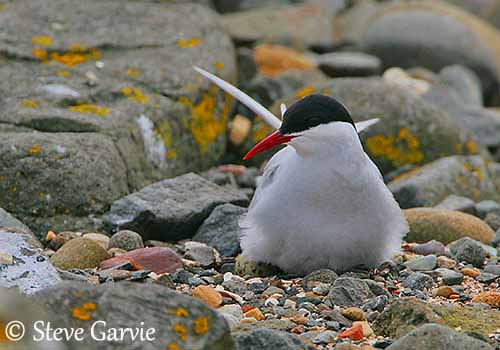
Noddies are closely related to the terns. They look slightly different in appearance, and these species range mainly in tropical regions. They feed on fish and squid, and are able to catch flying-fish in the air.
Skimmers differ from other Laridae by the stunning structure of the bill, showing shorter upper mandible, perfectly adapted to their feeding behaviour. Their foraging method is unique among birds. The bird flies along and “ploughs” the water with the long lower mandible. The bird skims an area of about 50-100 metres before flying up. Then, it turns and skims the same area again.
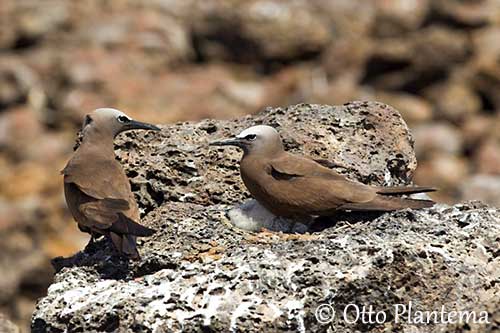
With chick at nest
Almost all the members of the family Laridae breed colonially and often in mixed colonies with other seabirds’ species, and occasionally as solitary pairs.
Gulls, terns and skimmers usually nest on sandy beaches, bare rocks, among reeds or other vegetation, or in vegetated sand dunes. The nest is a scrape, a shallow depression, sometimes lined with some vegetation, pebbles or shells. The colony is often in coastal locations or on islands, coral cays, rocks… The gulls of the genus “rissa” establish the colonies on narrow cliff ledges.
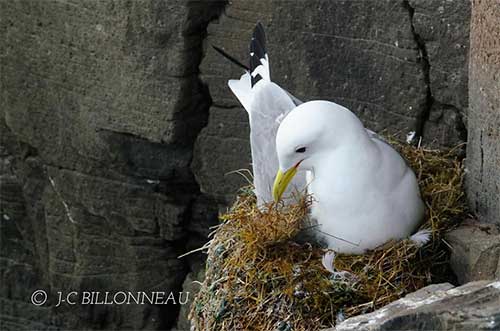
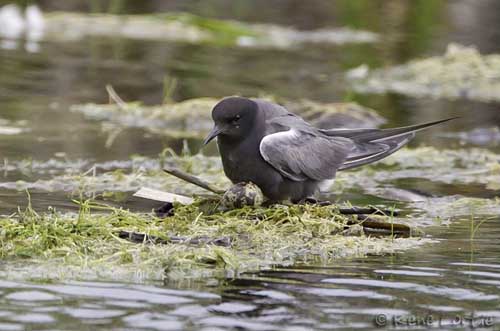
Some terns’ species nest in marshes, and build floating nests. But the Inca Tern nests mainly in crevices, fissures, burrows, holes in rocks, at base of rocky cliffs and boulders, in abandoned seabirds’ burrows and even on ledges of human structures. The White Tern does not build any nest. The female lays only one egg in a small depression on bare branch.
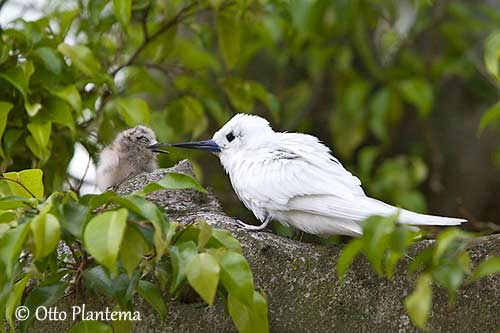
The goal of all species is to defend the nest-site against predators and other pairs. Nesting in colonies involves more safety but also promiscuity which sometimes favours polygamy and disputes. The solitary nesters have to find hidden nest-sites with good view on the surroundings.
The family Alcidae is a very old family with roots extending back 30-40 million years earlier of more. It includes several bird species such as Auks, auklets, guillemots, murrelets, murres, puffins and the Razorbill. They are able to perform a fast whirring flight. They are good divers and swimmers and pursue their prey underwater, propelled by their short, powerful wings, the short legs and the webbed feet. However, the legs are placed far back on body, making the birds usually clumsy on land while walking with an upright posture.
The breeding season drives the auks to land for nesting. They usually prefer offshore rocky islands or headlands, in order to avoid predation. The breeding habitat of Cepphus guillemots requires rocky crevices or fissures in cliffs and boulder fields, but they also use abandoned burrows of other species and even artificial cavities in old structures.
The puffins nest in self-excavated burrows in the ground of maritime slopes. Among the puffins, some species favour grassy maritime slopes, whereas others nest in rock crevices on sea cliffs or slopes.
The small murrelets of genus Synthliboramphus nest in cavities and hollows around tree roots or logs, and also in rock crevices, whereas others excavate holes in soft ground.
The Little Auk or Dovekie and most of the small auklets often nest in sea-facing scree slopes and boulder fields, rock rubble along the coastal beaches, and steep cliffs.
The nests of the skimmers are on the ground. They are unlined and can be situated on sandbanks of large rivers, or on islands in lakes.
Noddies nest mainly in rocky areas such as cliff ledges, crevices in rock, slopes, but also in trees. The nests are not fully concealed, but they often are inaccessible to most predators.
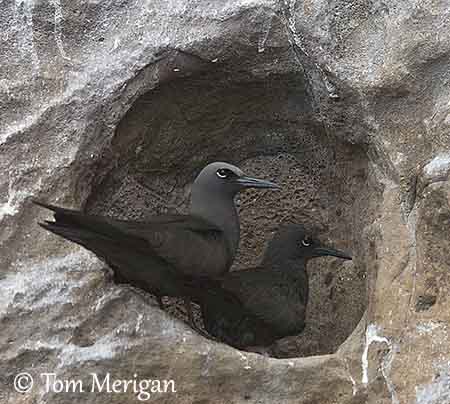
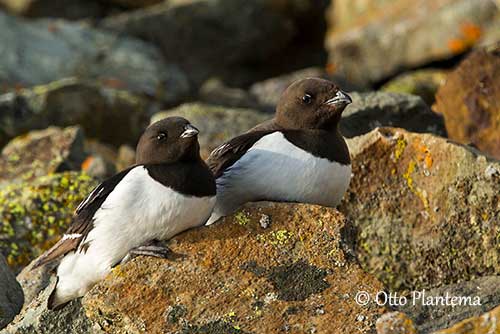
The nesting habitat of Alcids varies, but most species breed in colonies established on rocky islands and sea cliffs along the coasts. However, some of them breed in small groups and sometimes as solitary pairs.
The Marbled Murrelet nests high on branches in the upper canopy in coniferous forests, whereas the Long-billed Murrelet builds a nest in tree on a pile of mossy branches, but only 5-7 metres above the ground.
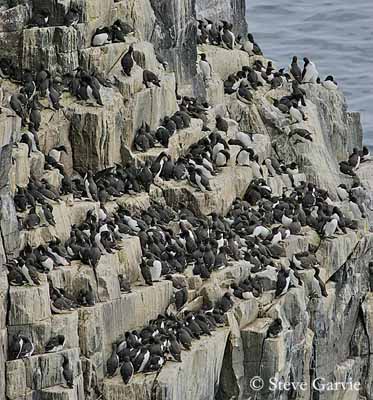
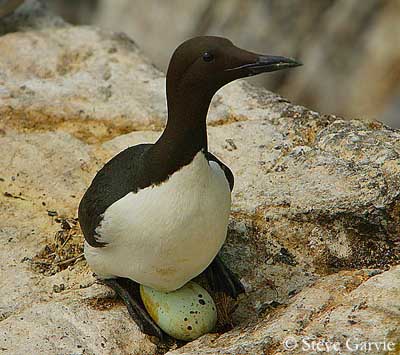
Most of them return to their breeding grounds several weeks or months before the egg-laying, during which they strengthen the pair-bonds, occupy the breeding site, mate and prepare the site for the egg. They usually show high fidelity to colonies and breeding sites, and often return to the same colony in several following years.
The chicks spend considerable time exercising their wings by flapping them vigorously, inside the nest or outside near the entrance. When the young are ready to depart, most of them climb to higher points to help them to fly off into the air, or make short flights down the slopes to the cliff edge from which they take flight. They perform a spectacular “parachute” flight while descending from high cliffs of 200-300 metres high, followed by the parents that call continuously to maintain contact with their young, before to leave quickly the colony in family group.
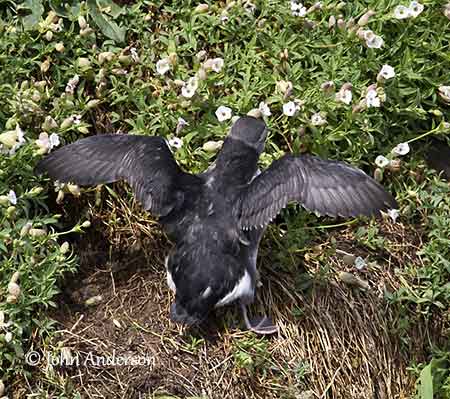
Juvenile exercising its wings at burrow entrance